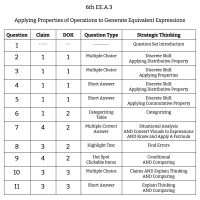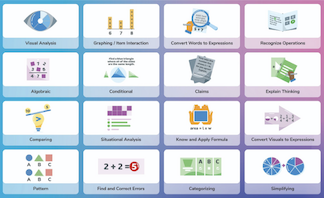
6th Grade Math - EE.A.3 - Apply Properties of Operations to Generate Equivalent Expressions
11 Questions
Applying Properties of Operations to Generate Equivalent Expressions Introduction
Which expression is equivalent to 8a?
Which of the expressions below is NOT equivalent to y + y + y + y + 4?
Use the distributive property to simplify the expression 3(8 + 2y). Type in your answer.
Use the commutative property to write an equivalent expression to 6y + 2.6. Type in your answer.
Match each equivalent expression pairing to the property being applied.
Janie wants to find the combined area of the two rectangles below. Which TWO expressions could she use to find the correct area?
Indira makes a mistake in her thinking while solving the problem below. Click on the first step that contains an error.
Click on the TWO expressions that meet the following criteria.
Jonele argues that (y x 1) and (y + 0) will always be equivalent to one another regardless of what the value of y is. Do you support her claim? Explain.
Determine whether the two expressions below are equivalent. If so, tell what property is applied. If not, explain why. Type in your answer.

We help districts in California boost CAASPP Math Scores by Δ +20% by helping teachers determine if students are struggling with the content, the technology involved with the type of question, or the type of strategic thinking required. Based on the 8 Standards for Mathematical Practice, our platform and professional development empowers teachers to recognize all 16 types of strategic thinking across any math question, curriculum, or assessment.
Learn more